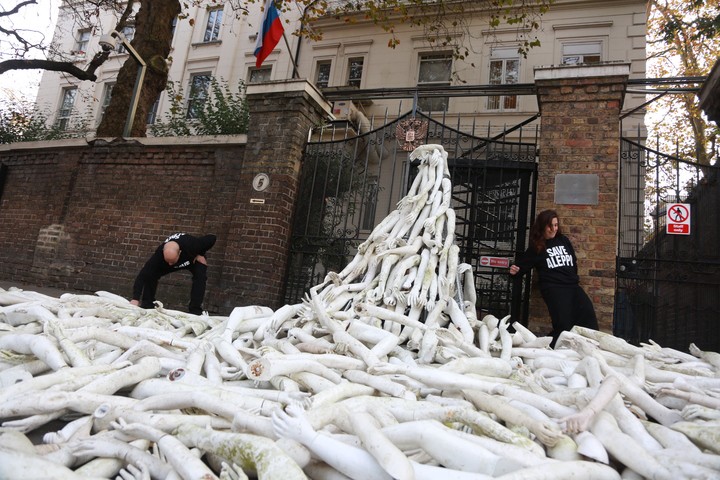Limbs at the Russian Embassy
This was a direct action that took weeks of secretive planning. Our goal was to organise an attention-grabbing visual protest to draw attention to the escalation of the siege of Aleppo where dozens of airstrikes were hitting hospitals and crowded civilian areas. We wanted to scatter hundreds of plastic limbs at one of the entrances of the Russian embassy in London, effectively blocking it. This would send a message to Russia that people worldwide knew it was committing war crimes in Aleppo and were determined that it should stop. We organised the action in partnership with an organisation that had years of experience in visual protests and that wished to remain anonymous.

The event needed to be kept under wraps so that the police and the embassy didn’t get wind of it and shut it down. To that end, we always discussed it using a code name and didn’t apply for a protest permit. It was our way of enforcing some kind of accountability given the international community was looking away from Syria and was preoccupied with the US elections.
Our partner organisation procured the limbs and we worked with them on a precise plan for the day with a minute-by-minute timetable for those taking part. This was crucial to ensuring that the direct action was carried out seamlessly. We only had two or three minutes to arrange hundreds of limbs at the entrance to the embassy and chain ourselves to the gate. Every direct action should have a minute-by-minute timetable.
Roles were agreed ahead of the action. We appointed a direct action coordinator, who was the person in charge. This person made all the ultimate decisions: all members of the team had to follow their directions. This is a critical role when things are moving quickly and publicly to avoid confusion. The direct action coordinator was also responsible for signalling the end of the demonstration, which was important to avoid confusion. All participants walked away in pairs or groups of three in different directions to avoid being identified or subject to repercussions.
There was also a police coordinator whose role was to immediately greet the police when they arrived, show their hands, and explain that this was a peaceful protest. The tone of a police coordinator should be friendly and cooperative while also firm to ensure that the goals of the action are met.
We had told trusted media contacts in advance about the action under total embargo. Giving the press a heads up is critical to ensuring coverage as reporters are more likely to cover your event when it’s live than if they find out about it afterwards through a press release or on social media.
We broadcast the whole action on Facebook as a live video, which received 713,000 views, close to 11,000 shares, and 16,000 reactions. Facebook Lives are very effective for direct actions and visual actions as people want to follow along as the event unfolds. Spokespeople should be prepared in advance to speak to the camera.
ANA Press made a video of the event, which generated a lot of discussions online, getting more than 4,000 reactions and 457 comments on Facebook. We also immediately uploaded photos and videos of the event for journalists to use and wrote about it on Medium. After the action, the Russians falsely claimed that we had locked them in the embassy when we had only blocked one entrance. We decided not to deny this as it made our campaign sound stronger!
“Today we blocked the Russian Embassy in an attempt to disrupt their plans to unleash further hell on the people of Aleppo. Maybe some of the pictures bubbled up on your news feed — limbs strewn alongside a tangle of activists on what is otherwise is a normal London street.”
Medium post about the protest
Russia also made a formal complaint to the UK about our action, particularly as the then-Foreign Secretary Boris Johnson had also called for demonstrations outside the embassy. On its website, the embassy wrote: “Today (3rd November) a protest action by a group of people interrupted the work of the Embassy as the entrance to the Consular Section was blocked up with a heap of mannequin body parts, while the protestors handcuffed themselves to the gate… Moreover, nuisance callers blocked the Embassy telephone line rendering it impossible to contact the mission for genuine callers.”
The visual nature of the campaign and its boldness ensured our coverage in the Independent, the Evening Standard, Radio Free Europe, the New Arab, and the Telegraph. It was also covered by the pro-Russian outlet, Russia Today.
What we learnt
Direct actions require a lot of advanced planning and carry risks, but they can be highly effective in generating noise or coverage for an important campaign.